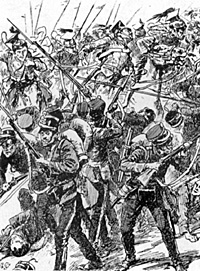 "Captain Von der Decken, commanding the left
squadron, could see the effect of this fire on the leading
squadron, and he knew that he must run the gauntlet of the
same death-dealing musketry. He at once decided to charge
the nearest French square, although the ground favoured
infantry more than cavalry and despite the fact that there
was no artillery available to redress the balance and clear
a passage for his sabres. Wheeling his squadron into line,
he led it headlong against the French, who greeted him with
volley after volley. The dragoons enveloped two sides of the
square but could not break into it. The two front ranks of
the infantry were kneeling, and behind them were four more
ranks standing. Fluttering over the centre of the square
were the bullet-torn colours, and out in front were the
lightly equipped skirmishers picking off the leading
dragoons. Von der Decken was one of the first of his
squadron to fall.
"Captain Von der Decken, commanding the left
squadron, could see the effect of this fire on the leading
squadron, and he knew that he must run the gauntlet of the
same death-dealing musketry. He at once decided to charge
the nearest French square, although the ground favoured
infantry more than cavalry and despite the fact that there
was no artillery available to redress the balance and clear
a passage for his sabres. Wheeling his squadron into line,
he led it headlong against the French, who greeted him with
volley after volley. The dragoons enveloped two sides of the
square but could not break into it. The two front ranks of
the infantry were kneeling, and behind them were four more
ranks standing. Fluttering over the centre of the square
were the bullet-torn colours, and out in front were the
lightly equipped skirmishers picking off the leading
dragoons. Von der Decken was one of the first of his
squadron to fall.
In face of such a wall of musketry and steel, it seemed that the wave of horsemen must break and fall back, but at the crucial moment a shot, killed one of the dragoon horses and it fell with its rider on top of the French ranks. The opening was made and with a wild yell the dragoons urged their terrified and snorting horses into the gap. It was like the flood which follows the bursting of a dam. The infantry disappeared under the onrush of slashing, yelling, thrusting horsemen, the confusion made a thousand times worse by the plunging and kicking of the fear-maddened horses. By the time the dragoons were finished the entire battalion had either been cut down or taken as prisoners, and where the square had once stood lay the disembowelled carcosses of nearly forty horses.
Meanwhile the third squadron of the Ist Dragoons under Captain Von Reitzeuslen had followed Von der Decken's example and charged the second French square. This was drawn up on the edge of the heights and it was even better placed to drive back cavalry. But its morale was shaken by the fate of the other battalion. The cohesion essential if infantry was to withstand the shock action of cavalry was ruined by a number of soldiers who broke the ranks and took to their heels. The dragoons smashed their way into the gaps left by the fugitives and sabred their way through to the other side of the square; then, rallying as one man to the trumpet-call, they rode back the way they had come and completed the rout.
A few unwounded French officers hastily rallied the survivors and attempted to form a third square. This in its turn was charged and destroyed by the two squadrons of the 2nd Dragoons which had been following behind their sister regiment. Foy's rearguard had ceased to exist as an effective fighting force, and all who remained alive and untaken were withdrawn to some rising ground near the Peneranda road. The King's German Legion followed them, but by now their horses had been virtually ridden into the ground. The French held them off with the courage that is lent by despair, picking up the stones which littered the ground and hurling them at the legs of the heaving and staggering horses. Wellington then sent orders for the dragoons to retire, and they made their way slowly back to the rear through the cheering ranks of the British infantry. They left behind them in the valley of Garcia Hernandez fifty-two dead dragoons and sixty-seven dead horses; their wounded totalled slightly more."
From: Charge to Glory by James Lunt.
Back to Table of Contents -- Wargamer's Newsletter # 154
To Wargamer's Newsletter List of Issues
To MagWeb Master Magazine List
© Copyright 1975 by Donald Featherstone.
This article appears in MagWeb (Magazine Web) on the Internet World Wide Web.
Other military history articles and gaming articles are available at http://www.magweb.com